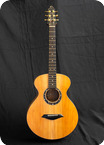Ehlers Guitars / 16C / Black / Guitar
Model: 16C
Top: Adirondack
Red Spruce
Back and sides:
Figured Mahogany
|
EHLERS GUITARS • OPTIONS
|
|
| Body Options Cutaway: Rounded, hand-bent cutaway (as opposed to pointed or sharp): $600 Sharp or pointed cutaways: not offered for reasons of aesthetic repulsivity! Slotted Peghead (With Waverly Engraved Tuning Machines): $600 |
|
|
Top Options: all options below included in base price |
|
|
Back & Side Options All Curly Koa - Back, Sides, and Top (matched sets all cut from same tree) Curly European Maple AAAA Grade (includes Maple Neck): $400 Cocobolo Rosewood AAAA Grade: $750 Madagascar Rosewood (four-piece back) Brazilian Rosewood (two-piece back): $3000 - $5000 Brazilian Rosewood (three-piece back): $2500 - $3000 Figured Brazilian Lacewood (No cutaway option): $400 Quilted Mahogany AAAA Grade (No cutaway option): $400 Macassar Ebony AAAA: $800 Curly Walnut AAAA Grade: $600 Bolivian Rosewood AAAA Grade: $300 Honduras Rosewood AAAA Grade: $350
|
|
| Tuning Machines Options Nickel Waverly (with or without ebony buttons): $250 Other Waverly models available
|
|
| Inlays Troubadour Peghead Inlay: $475 |
|
| Abalone Border Purflings Abalone Rosette: Standard (Premium Paua) |
|
| Finish Options Black Lacquer Top (with tortoise shell bound soundhole): $250
|
|
| Nut, Saddle, & Bridge Pins Antique Ivory Nut & Saddle: $200 Fossilized Ivory Bridge Pins & End Pins: $375 |
|
| Necks Mahogany: standard |
|
| Bridges: String spacing 2-1/8”, 2-1/4”, or 2-3/8”
Ebony - Original Stairstep Design: $0 |
|
| Binding Options Ebony, Extra Curly Koa, Brazilian Lacewood, Madagascar Rosewood, Cocobolo, Tortoise Shell Celluloid, Herringbone Purfling: no extra charge (Side lines optional)
|
|
| Cases TKL Hardshell Case - Velour lined w/arched top: $200 Cedar Creek Deluxe (arched top & arched back): $400 Flight cases available |
Ehlers Guitars, Mexico 
ABOUT ROBERT EHLERS • GUITAR MAKER
Rob Ehlers began building steel string guitars in 1968 in Santa Monica, Cal with his then partner Ren Ferguson (who later went on to become Vice President of Gibson acoustic guitars). They built Martin style dreadnought and 000 models.
In 1971 Rob moved to Portland OR where he continued building guitars.
In 1973, Bruce Burns came to work for Rob as an apprentice, and later they worked together as partners. At that time most players were using dreadnought , 000, or 00 size guitars. Rob thought that there was a place for a sound that had less bottom end than the dreadnought, but offered more in terms of balance and volume than the 000 size body. The Ehlers and Burns 15 1/2 cutaway model was the result of their joint effort in designing and building such an instrument. This medium size, round bodied, cutaway guitar, with a fingerboard extension that allows 24 frets and was designed primarily for fingerstyle playing, was the first of its kind.
Now, nearly 33 years later, various nearly identical guitars of this style are being made by dozens of guitarmakers.
Rob shows off a dred. Since 1976, most of the guitars that Rob has made have retained that original design work and aesthetic. The 15 1/2 model is still being made, but in 1989 Rob began building a larger version that has a lower bout measurement of 16 inches and consequently a bigger sound.
In 1992, Rob designed his version of the " Jumbo" size body, with a lower bout measurement of 17 inches.
In 2001, Rob decided to build a narrow bodied guitar that could be electrified but would also have an excellent acoustic sound. The 3" deep "Thinbody" is the very successful result.
In 2003 Rob started making his version of the Selmer-Maccaferri style guitar with an oval soundhole and an X braced top that produces a much warmer sound than the originals. This model has recently been retired.
Also in 2003, Rob started making two archtop guitars of his own design, as well as F-style mandolins.
Russ works his magic at the sanding machine.
In 2004, Rob finally designed his Parlor Guitar, with either 12 or 14 frets to the body and an optional slotted peghead. The other guitars that Rob makes are a near reproduction of the 1919 Martin-Ditson "Ladies Model" and an occasional dreadnought.
In 2006 Rob began designing a 12 string guitar in the style of the old Stella "Leadbelly" model.
After 30 years of guitarmaking in the U.S.A., Rob moved to a small town in the mountains of Veracruz, Mexico and continues making his guitars the way he always has--one at a time, by hand. No CNC machines or mass production techniques are used.
In 2005, Rob's brother Russ began working with him as his partner, and, with Miguel "Naco" Hernandes doing the hand rubbed lacquer finishes, they produce 45-50 guitars per year.
They have no plans of increasing their production.













